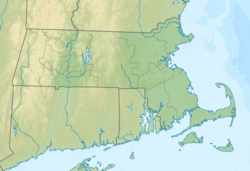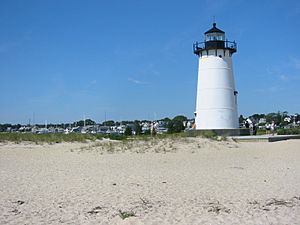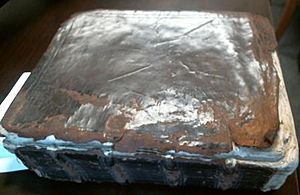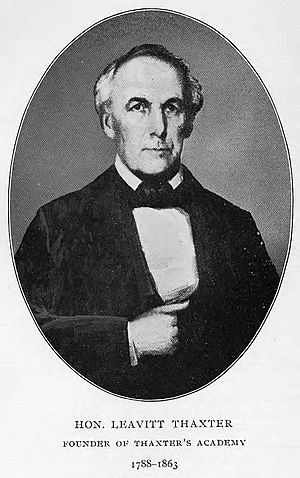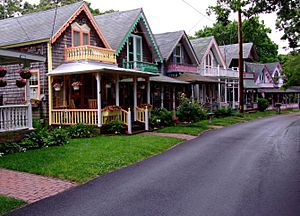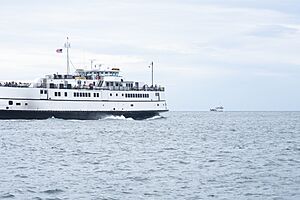Martha's Vineyard facts for kids
|
Nickname: The Vineyard, The Rock
|
|
|---|---|
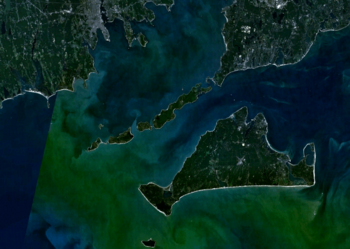
Martha's Vineyard and the Elizabeth Islands
|
|
| Geography | |
| Location | Dukes County, Massachusetts |
| Coordinates | 41°24′N 70°37′W / 41.400°N 70.617°W |
| Major islands | Martha's Vineyard, Chappaquiddick |
| Area | 96 sq mi (250 km2) |
| Length | 20.5 mi (33 km) |
| Coastline | 200 km (124 mi) |
| Highest elevation | 311 ft (94.8 m) |
| Highest point | Peaked Hill |
| Administration | |
|
United States
|
|
| State | Massachusetts |
| County | Dukes |
| Demographics | |
| Population | 20,530 (2023) |
| Pop. density | 179.8 /sq mi (69.42 /km2) |
Martha's Vineyard, often called the Vineyard, is an island in the U.S. state of Massachusetts. It lies just south of Cape Cod. The island is famous as a popular place for summer vacations, especially for many well-off families. It also includes the smaller Chappaquiddick peninsula.
Martha's Vineyard is the 58th largest island in the United States. It covers about 96 square miles. It is also the third-largest island on the East Coast. Only Long Island and Mount Desert Island are bigger. Most of Dukes County, Massachusetts is made up of Martha's Vineyard. This county also includes the Elizabeth Islands and Nomans Land.
The number of people living on the island all year has grown a lot since the 1960s. In 2023, about 20,530 people lived there year-round. This is up from 16,460 in 2010. But in the summer, the population can grow to over 200,000 people! About 56% of the homes on the Vineyard are used only during certain seasons. Living on Martha's Vineyard can be very expensive. The cost of living is much higher than the national average.
The island is believed to be named after the daughter of Bartholomew Gosnold. He was a British explorer who came to Cape Cod in 1602. A smaller island nearby was first called "Martha's Vineyard." But later, this name moved to the main island we know today. It is one of the oldest English place-names still used in the United States. For a while, some people called it Martin's Vineyard. This might have been after John Martin, the captain of Gosnold's ship.
When the U.S. Board on Geographic Names tried to make place-names standard, they removed apostrophes. So, for a time, it was officially Marthas Vineyard. But the Board changed its mind later. Now, Martha's Vineyard is one of only five places in the U.S. that uses a possessive apostrophe. Native Americans called the island Noepe or Capawock.
Contents
History of Martha's Vineyard
Early Exploration and Native People
The island was first home to the Wampanoag people. In their language, it was called Noepe, meaning "land amid the streams." In 1642, about 3,000 Wampanoag people lived on the island. By 1764, their numbers had dropped to 313.
The English explorer Bartholomew Gosnold sailed to the island in 1602. He named a smaller island to the south "Martha's Vineyard." This name was later given to the main island. It is thought he named it after his mother-in-law or his daughter, both named Martha.
Colonial Settlement
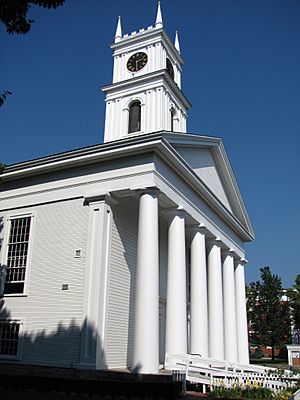
English settlement began when Thomas Mayhew bought Martha's Vineyard and other nearby islands. He had good relationships with the Wampanoag people. He respected their land rights. His son, also named Thomas Mayhew, started the first English settlement in 1642. This was at Great Harbor, which later became Edgartown, Massachusetts.
The younger Mayhew became friends with Hiacoomes, a Native American neighbor. Hiacoomes' family became Christian. Many Wampanoag people on the island also became Christian. During King Philip's War, the Martha's Vineyard Wampanoag did not join the fight. This showed the good relations Mayhew had built.
In 1657, the younger Thomas Mayhew was lost at sea. His grandsons, Matthew Mayhew and John Mayhew, helped run the family's business and government. In 1683, Dukes County, New York was formed, including Martha's Vineyard. Later, in 1691, the island became part of Massachusetts.
Native American students from Martha's Vineyard were among the first to graduate from Harvard. This included Joel Hiacoomes, Hiacoomes' son, and Caleb Cheeshahteaumauk. They studied languages like Hebrew, Greek, and Latin.
Later, Hon. Leavitt Thaxter became a leader in the community. He was an educator and a friend to the Native Americans. He helped run Thaxter Academy, a school that taught both white and Native American students.
19th Century Whaling and Tourism
Like Nantucket, Martha's Vineyard became important in the 1800s because of the whaling industry. Ships sailed worldwide to hunt whales for their oil. But when petroleum was discovered in Pennsylvania, it provided a cheaper oil source. This caused the whaling industry to almost disappear by 1870.
After a railroad reached Woods Hole in 1872, people started building summer homes on the island. Communities like Harthaven began to grow. Even though the island faced financial struggles during the Great Depression, it became more famous as a resort for tourists and wealthy people. There is still a large Wampanoag population on the island, mainly in the town of Aquinnah. Its name means "land under the hill" in the Wampanoag language.
The island was also the last home of the Heath hen. This bird was once common but died out in 1932.
Modern Times and Famous Events
In 1969, the Chappaquiddick incident happened. A car driven by U.S. Senator Ted Kennedy went off a bridge, and Mary Jo Kopechne died. This event brought international attention to the island.
In 1974, director Steven Spielberg filmed the movie Jaws on Martha's Vineyard. Many islanders appeared in the movie as extras. Scenes from Jaws 2 and Jaws: The Revenge were also filmed there.
In 1977, some islanders thought about leaving Massachusetts. They even considered becoming the 51st state! This idea didn't happen, but it got a lot of attention.
Many famous people have visited or lived on Martha's Vineyard. Bill Clinton and Barack Obama both spent vacations there during their presidencies. In 1999, a plane crash off the coast of the island killed John F. Kennedy Jr., his wife, and her sister. Kennedy's mother, Jacqueline Kennedy Onassis, had a home in Aquinnah.
In the early 2000s, scientists studied an outbreak of tularemia (rabbit fever) on the island. They found that Martha's Vineyard was the only place where people got tularemia from lawn mowing. This research helped them learn more about preventing diseases.
Hereditary Deafness and Sign Language
For nearly 200 years, Martha's Vineyard had a very high rate of hereditary deafness. By the late 1800s, about 1 in 155 people on the island were born deaf. This was much higher than the rest of the country.
Because of this, many hearing residents also learned Martha's Vineyard Sign Language (MVSL). This allowed deaf people to be a full part of the community. They worked in fishing and farming, and everyone communicated easily. However, as more people moved to and from the mainland, the unique sign language tradition slowly faded. The last deaf person born into this tradition passed away in 1952.
Climate and Weather
Martha's Vineyard has a climate that is influenced by the Atlantic Ocean. This means that temperatures are usually milder than inland areas. Winters are cool, but temperatures rarely drop below 0°F. Most winter days are above freezing. The island gets about 25 inches of snow each year. Summers are warm and mild, with temperatures rarely going above 90°F. The warmest months are July and August. The island receives a good amount of rain throughout the year.
Towns of Martha's Vineyard

Martha's Vineyard is divided into six towns. Each town has its own local government. The towns also work together on island-wide issues through the Martha's Vineyard Commission. This group helps with building, environment, and keeping the island beautiful.
Some services, like schools and waste management, are shared by the towns. The six towns are:
- Tisbury: This town includes Vineyard Haven, which is the main port for ferries and cargo.
- Edgartown: This town includes Chappaquiddick Island. Edgartown is known for its history with whaling. It is the largest town on the island by population and size.
- Oak Bluffs: Famous for its "gingerbread cottages" (colorful Victorian homes). It has a lively downtown area and is known for its nightlife. It was once called "Cottage City." Oak Bluffs has been a popular spot for African Americans since the early 1900s.
- West Tisbury: This is the island's farming center. It hosts the popular Martha's Vineyard Agricultural Fair every August.
- Chilmark: This town includes the fishing village of Menemsha. Chilmark is mostly rural and has the hilliest parts of the island.
- Aquinnah: Formerly called Gay Head, this town is home to the Wampanoag Indian tribe and features beautiful clay cliffs.
The towns of Edgartown, Tisbury, and Oak Bluffs are "wet" towns, meaning they serve alcohol. West Tisbury and Aquinnah are "soggy" towns, serving only beer and wine. Chilmark is a "dry" town.
Getting Around Martha's Vineyard
By Water
Martha's Vineyard is about seven miles off the coast of Cape Cod. You can get there by ferry from several places. The main ferry leaves from Woods Hole, Massachusetts. Other ferries come from Falmouth, New Bedford, Hyannis, and even Manhattan in New York City. The trip from New York City takes about five hours.
By Air
The Martha's Vineyard Airport (MVY) offers many flights to the island. Cape Air flies year-round from Boston, Hyannis, and Nantucket. During summer, other airlines like American Airlines and JetBlue offer seasonal flights from cities like New York and Washington. The airport also handles many private planes. There's also Katama Airpark, which has grass runways and is popular with private pilots.
By Bus
Bus service is available on the island all year long. It is provided by the Martha's Vineyard Transit Authority (VTA).
Education on the Island
Martha's Vineyard has its own public school system.
- Edgartown School (Grades K-8)
- West Tisbury School (Grades K–8)
- Oak Bluffs School (Grades K–8)
- Tisbury School (Grades K–8)
- Chilmark School (Grades K–5)
- Martha's Vineyard Public Charter School (Grades K–12)
- Martha's Vineyard Regional High School (Grades 9–12)
Most towns have their own elementary schools. Students from Aquinnah usually go to Chilmark's elementary school. The Chilmark school only goes up to 5th grade, so older students go to the West Tisbury school for middle school. The Martha's Vineyard Public Charter School is in West Tisbury and teaches students from kindergarten to 12th grade. It serves the whole island. All high school students on the island attend Martha's Vineyard Regional High School in Oak Bluffs.
Fun Things to Do and Island Life
The Vineyard became a popular place for tourists because of its nice summer weather and beautiful beaches. It's a place where people come to relax. The island has many places to stay, like large hotels, boutique hotels, and traditional inns. Many visitors also rent private homes.
In the past, wealthy sea captains built large homes on Martha's Vineyard. Today, it's a famous summer spot in the Northeastern United States. Many celebrities visit regularly.
The island has about 20,530 year-round residents. But in summer, the population jumps to 200,000, plus many short-term visitors. The busiest time is around July 4th and the Agricultural Fair in late August. The summer season usually runs from June through Labor Day.
The island is also known for its local wine. The Martha's Vineyard AVA is a special area for wine production.
Other popular attractions include:
- The annual Grand Illumination in Oak Bluffs, where many gingerbread cottages light up.
- The Martha's Vineyard Film Center, which shows independent movies.
- The historic Capawock and Strand theatres.
- Film festivals like the Martha's Vineyard Film Festival and the Martha's Vineyard African-American Film Festival.
- The Farm Institute at Katama Farm in Edgartown.
- The Flying Horses Carousel in Oak Bluffs, which is the oldest operating carousel in the U.S.
- The Martha's Vineyard Skatepark in Oak Bluffs, which is open to the public.
Island Residents and Culture
The island's small year-round population means that people are very involved in local issues. They care a lot about tourism, development, and protecting the island's nature. It's important to balance the need for tourism with keeping the island's natural beauty safe.
Many summer visitors have deep family roots on the island. They come back year after year. But many others are renters who see the island as a "home away from home."
Martha's Vineyard has been home to many artists and musicians, like James Taylor and Carly Simon. Famous authors like Judy Blume and Norman Bridwell have also lived there. Many writers have been inspired by the island, setting their stories there.
Many well-known people, including former presidents Bill Clinton and Barack Obama, visit the island. Other celebrities like David Letterman, Bill Murray, and Spike Lee also enjoy the Vineyard. Locals usually respect the privacy of famous visitors.
Since the 1800s, the island has had a large community of Portuguese-Americans. They traditionally worked in whaling and fishing. Today, there's also a large community of Brazilian immigrants who help maintain the island's vacation homes.
Living on Martha's Vineyard can be tough for year-round residents. Their wages are often lower than the state average, but the cost of living is much higher. This has caused some families to move away. However, many high-profile residents help raise money for island organizations and services. The biggest fundraiser is the annual Possible Dreams Auction.
Media on Martha's Vineyard
Local Newspapers
- Vineyard Gazette
- The Martha's Vineyard Times
Radio Stations
- WMVY/88.7-Edgartown: Plays a variety of music.
- WBUA/92.7-Tisbury: Relays public radio from Boston.
- WVVY-LP/96.7-Tisbury: A community radio station.
Television
- MVTV: Martha's Vineyard Community Television (Comcast Channels 13, 14, 15).
Images for kids
-
Old Whaling Church, Edgartown Village Historic District
See also
 In Spanish: Martha's Vineyard para niños
In Spanish: Martha's Vineyard para niños


